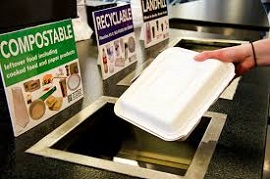Where can commercially compostable packaging and serviceware be processed in New Zealand?

Most compostable coffee cups and packaging can only be composted in commercial composting facilities. This is because the compost pile needs to reach a temperature of 55 degrees or higher to break down these items, which almost all home composting systems don’t achieve.
There are 10 industrial facilities in New Zealand and two community facilities that currently accept compostable packaging. Compostable packaging is not accepted in council kerbside food waste collections or privately provided greenwaste collection bins. In most cases, a waste company must be used to collect and transport compostable packaging to a composting facility.
Please visit the wasteminz website for a list/map of the current facilities available, the compostable packaging they accept, and the waste companies that can be used to deliver packaging to the facility. This list is accurate as of June 2022.
If you would like your facility to be listed, please email This email address is being protected from spambots. You need JavaScript enabled to view it.
Why can some facilities accept compostable packaging and others not?
In New Zealand, commercial composters use a variety of methods to create compost such as windrow, aerated static piles, vermicomposting, or in-vessel methods and the compostable items that go into a commercial composting system are called feedstock.
Composting facilities need to apply for a resource consent to operate and the conditions of the resource consent can limit and/or restrict the type of feedstock they can accept. Composting facilities in New Zealand can generally be classified as:
Greenwaste processing facilities
These facilities process garden waste, bark and wood chip to make compost or mulch and generally don’t have a resource consent or an appropriate composting process to accept food waste or compostable packaging.
Industrial composting facilities
These facilities process complex waste streams such as food waste, waste from abattoirs or fish processing facilities, sludge etc. and are more likely to be able to process compostable packaging. However, resource consent conditions can vary and may not allow for compostable packaging.
Litter is an issue as lightweight compostable packaging is susceptible to being wind-borne and litter management is a requirement of a commercial composter receiving a resource consent. This is particularly problematic if a composting facility is located near waterways or the ocean.
Other reasons that composting facilities may be unable to accept compostable packaging include:
- contamination issues (i.e. unwanted materials ending up in the mix)
- a lack of means to clearly identify certified compostable materials
- the length of a facility’s processing time
- issues with ratios of nitrogen-rich material (i.e. garden and food waste) versus carbon-rich material (i.e. compostable packaging)
- organic input restrictions, for example, organic certification (such as New Zealand’s BioGro organic certification) excludes any PLA (polylactic acid, plant-based plastic) feedstock.

Source : Wasteminz



